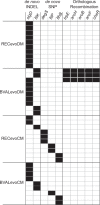Distribution of fitness effects of cross-species transformation reveals potential for fast adaptive evolution
- PMID: 36224268
- PMCID: PMC9751276
- DOI: 10.1038/s41396-022-01325-5
Distribution of fitness effects of cross-species transformation reveals potential for fast adaptive evolution
Erratum in
-
Correction to: Distribution of fitness effects of cross-species transformation reveals potential for fast adaptive evolution.ISME J. 2023 Aug;17(8):1352. doi: 10.1038/s41396-023-01440-x. ISME J. 2023. PMID: 37258654 Free PMC article. No abstract available.
Abstract
Bacterial transformation, a common mechanism of horizontal gene transfer, can speed up adaptive evolution. How its costs and benefits depend on the growth environment is poorly understood. Here, we characterize the distributions of fitness effects (DFE) of transformation in different conditions and test whether they predict in which condition transformation is beneficial. To determine the DFEs, we generate hybrid libraries between the recipient Bacillus subtilis and different donor species and measure the selection coefficient of each hybrid strain. In complex medium, the donor Bacillus vallismortis confers larger fitness effects than the more closely related donor Bacillus spizizenii. For both donors, the DFEs show strong effect beneficial transfers, indicating potential for fast adaptive evolution. While some transfers of B. vallismortis DNA show pleiotropic effects, various transfers are beneficial only under a single growth condition, indicating that the recipient can benefit from a variety of donor genes to adapt to varying growth conditions. We scrutinize the predictive value of the DFEs by laboratory evolution under different growth conditions and show that the DFEs correctly predict the condition at which transformation confers a benefit. We conclude that transformation has a strong potential for speeding up adaptation to varying environments by profiting from a gene pool shared between closely related species.
© 2022. The Author(s).
Conflict of interest statement
The authors declare no competing interests.
Figures






Similar articles
-
Genome-wide transformation reveals extensive exchange across closely related Bacillus species.Nucleic Acids Res. 2023 Dec 11;51(22):12352-12366. doi: 10.1093/nar/gkad1074. Nucleic Acids Res. 2023. PMID: 37971327 Free PMC article.
-
Adaptive evolution of hybrid bacteria by horizontal gene transfer.Proc Natl Acad Sci U S A. 2021 Mar 9;118(10):e2007873118. doi: 10.1073/pnas.2007873118. Proc Natl Acad Sci U S A. 2021. PMID: 33649202 Free PMC article.
-
Stress-Induced, Highly Efficient, Donor Cell-Dependent Cell-to-Cell Natural Transformation in Bacillus subtilis.J Bacteriol. 2018 Aug 10;200(17):e00267-18. doi: 10.1128/JB.00267-18. Print 2018 Sep 1. J Bacteriol. 2018. PMID: 29941421 Free PMC article.
-
Controlling competence in Bacillus subtilis: shared use of regulators.Microbiology (Reading). 2003 Jan;149(Pt 1):9-17. doi: 10.1099/mic.0.26003-0. Microbiology (Reading). 2003. PMID: 12576575 Review.
-
Experimental evolution of Bacillus subtilis.Environ Microbiol. 2017 Sep;19(9):3415-3422. doi: 10.1111/1462-2920.13831. Epub 2017 Jul 26. Environ Microbiol. 2017. PMID: 28631363 Review.
Cited by
-
DNA uptake from a laboratory environment drives unexpected adaptation of a thermophile to a minor medium component.ISME Commun. 2023 Jan 11;3(1):2. doi: 10.1038/s43705-022-00211-7. ISME Commun. 2023. PMID: 37938748 Free PMC article.
-
Genome-wide transformation reveals extensive exchange across closely related Bacillus species.Nucleic Acids Res. 2023 Dec 11;51(22):12352-12366. doi: 10.1093/nar/gkad1074. Nucleic Acids Res. 2023. PMID: 37971327 Free PMC article.
-
Trade-offs, trade-ups, and high mutational parallelism underlie microbial adaptation during extreme cycles of feast and famine.Curr Biol. 2024 Apr 8;34(7):1403-1413.e5. doi: 10.1016/j.cub.2024.02.040. Epub 2024 Mar 8. Curr Biol. 2024. PMID: 38460514 Free PMC article.

